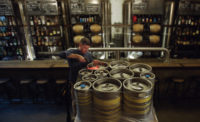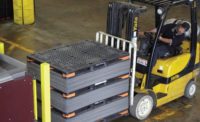Reusable packaging protects planet, improves bottom line
91 percent of plastic still not recycled

In the 1962 hit song “Return to Sender,” Elvis Presley croons, “Return to sender, address unknown. No such number, no such zone,” as he pines for a girl who won’t read his letter. In an age where sustainability, recyclability and reusability are not just buzzwords to protect the earth, beverage manufacturers are “reading the signs” and stepping up their actions when it comes to reusing materials and reducing packaging waste.
Three key factors guide the work of Stamford, Conn.-based Keep America Beautiful: convenience, communication and cause — getting consumers to understand the many benefits of recycling and why they should care, the website states.
On its website, 83,298 people signed up to take the hashtag #Recycled Pledge in support of the nonprofit’s Nov. 15 “America Recycles Day” program and to “clean up” their overall recycling commitment year-round. To date, 36 percent of respondents pledged to recycle plastic bottles and caps; plastic bags and wraps came in at No. 2 (29 percent); unwanted mail (16 percent); and cartons and mobile devices clocked in at 8 and 6 percent, respectively.
Drew Merrill, vice president of national accounts at Alpharetta, Ga.-based CHEP, discusses why leading consumer goods companies and retailers see physical waste as a significant risk.
“According to National Geographic, 91 percent of the world’s plastic packaging is still not recycled and if current trends continue, there will be 12 billion metric tons of plastic in landfills by 2050,” Merrill explains. “These metrics put consumer goods companies and retailers under pressure from consumers, employees, investors and social stakeholders to reduce single-use packaging through reusable alternatives. With major retailers setting public commitments — e.g., Walmart’s Project Gigaton and Kroger’s Zero Hunger Zero Waste — manufacturers are being pushed to seek quick, impactful, reusable solutions or risk losing market share and brand loyalty.
Hot-button topics
Experts note that many beverage companies have sustainability initiatives in place, brought on by the millions of plastic bottles in oceans, an evolving labor pool, SKU proliferation and companies tangibly exploring innovative ways to reduce the amount of single-use plastic bottles.
“There’s growing accountability and a heightened visibility on sustainable practices [as] companies and their stakeholders are more aware of the growing need to protect the environment and natural resources in the face of climate change,” explains Kat LaRocca, director of the beverage division at Rehrig Pacific Co. “Consumer demands are changing and beverage companies need to respond with more products. As their portfolio grows, their operations, supply chain and packaging are subject to increased complications.”
As a result, the Los Angeles-based company is seeing more “significant requests” for reusable packaging systems, including returnable secondary packaging and plastic pallets, as well as pallets that are equipped with radio-frequency identification (RFID) tracking systems.
Despite a higher initial cost, Rehrig Pacific’s plastic returnable crates and pallets equate to substantial financial and environmental benefits over the long haul, LaRocca says.
“A returnable asset can provide both financial and environmental benefits. The initial investment is typically higher; however, the total cost of ownership over the five to 10 year lifespan on the pallet or crate is significantly less per use than a one-way solution,” LaRocca explains. “From a sustainability standpoint, the products can be made with both virgin and recycled material. The typical lifespan of a crate is five to 10 years, and at the end of its usable life, it can be 100 percent recycled. The material can then be used in future assets.”
Reusable packaging — at its core — supports a circular economy, according to Andrea Nottestad, retail supply chain market manager for ORBIS Corp., Oconomowoc, Wis.
“ORBIS’ mission is to manufacture, use, reuse and reprocess as much packaging as we can without impacting the solid waste stream,” Nottestad says. “Our reusable packaging — from pallets and bulk containers for the processing plant to shells, finished goods pallets and mobile pallets for retail deliveries — can be a sustainable-material handling solution from the processing plant to the retail aisle.”
For instance, the company’s 44-by-56 PurMaxx uses reusable foam top frames to stabilize and secure loads of plastic, metal and glass containers during shipping from the container manufacturer to processing facilities. “Reusable packaging will continue to move product in the supply chain and can provide confidence to today’s retailer and consumer that their beverages will arrive safely,” Nottestad says.
Taking it a step further, CHEP created an initiative — a Zero Waste World Program — designed to help manufacturing companies eliminate waste, eradicate empty transport miles, and cut out inefficiencies to decrease carbon footprints by leveraging reusable packaging systems, CHEPS’ Merrill says.
“Our Zero Waste World program, launched in June, has already helped several large fast-moving consumer goods (FMCG) organizations adapt to the demand for a more sustainable and efficient supply chain,” Merrill says. “CHEP’s model is inherently circular as our pallets, crates and containers are shared and reused after each use.”
Sustainability and recyclability will remain key trends in the returnable containers market, industry suppliers note.
ORBIS’ Nottestad adds that there’s a push to find right-size packaging and to consolidate shipments to prevent wasted space on delivery vehicles.
“This optimization adds efficiency to delivery routes and maximizes the number of trips completed each day,” she says. “One plastic pallet example includes the 40-by-48 RackoCell pallet, which, when tested at the Virginia Tech Center for Unit Load design, cycled 200 times compared to wood pallets that traveled 11 trips.
“This re-use allows beverage processors to utilize reusable assets over a longer period of time, keeping their supply chain moving,” she continues. “Additionally, the dimensionally consistent sizing is more efficient for conveyance and automation than alternative pallets.”
Rehrig Pacific’s LaRocca notes the importance of returning assets back to companies and improving recycled content of bottles and containers,
The company currently is partnering with Purchase, N.Y.-based PepsiCo on a full lifecycle analysis that compares plastic reusable crates and one-way shrink packaging, she says. A whitepaper on the topic will be published in the next few months.
Tracking solutions
Experts expect advanced technology and innovation in monitoring reusable packaging through a range of tracking technologies to continue as suppliers seek to “close the loop.”
The brewing industry has realized benefits from returnable kegs with RFID tracking systems. For example, Germany-based Smartrac Technology Group recently launched a new Maxdura Keg product line with smart digitalization solutions and full traceability. The new hard tags, which are permanently glued to the inner face of the keg, provide reading rates of 100 percent, even when as many as 50 kegs are passing through an ultra-high frequency RFID gate, the company says.
In addition, the key tags record and manage a complete set of unique transponder data such as UID number, order number, batch number and yield in a controlled and secure way, it adds.
Traceability also remains key. “The quicker that returnable container returns back from the retailer, the more efficient and fewer containers are required,” ORBIS’ Nottestad says.
Beverage suppliers also must find new ways to go beyond consumer packaging and embrace reusability throughout their entire supply chains, Nottestad says. “Single-use packaging, pallets and delivery systems won’t fit into the supply chain of the future, and suppliers will increasingly turn to reusable packaging to meet the challenge of increasing consumer demand, improving uptime, ensuring future growth, customer confidence and continuous improvement.” BI
Looking for a reprint of this article?
From high-res PDFs to custom plaques, order your copy today!






